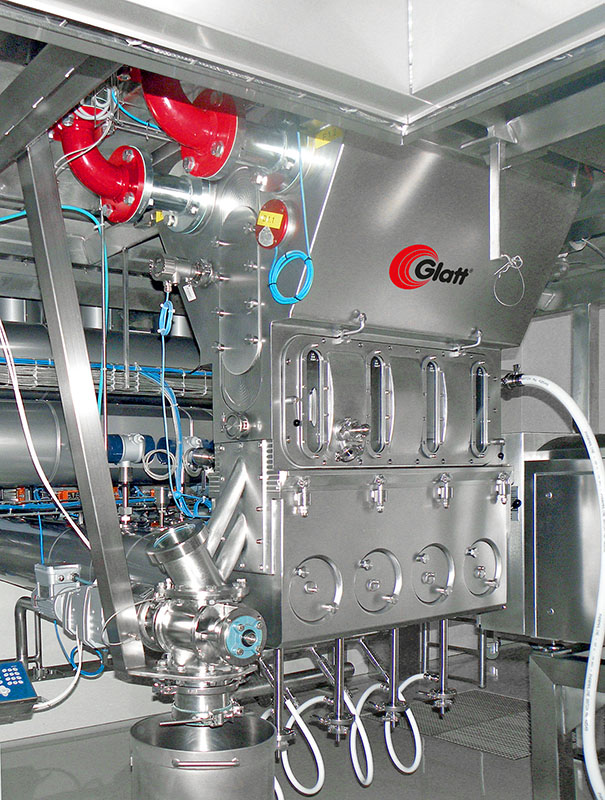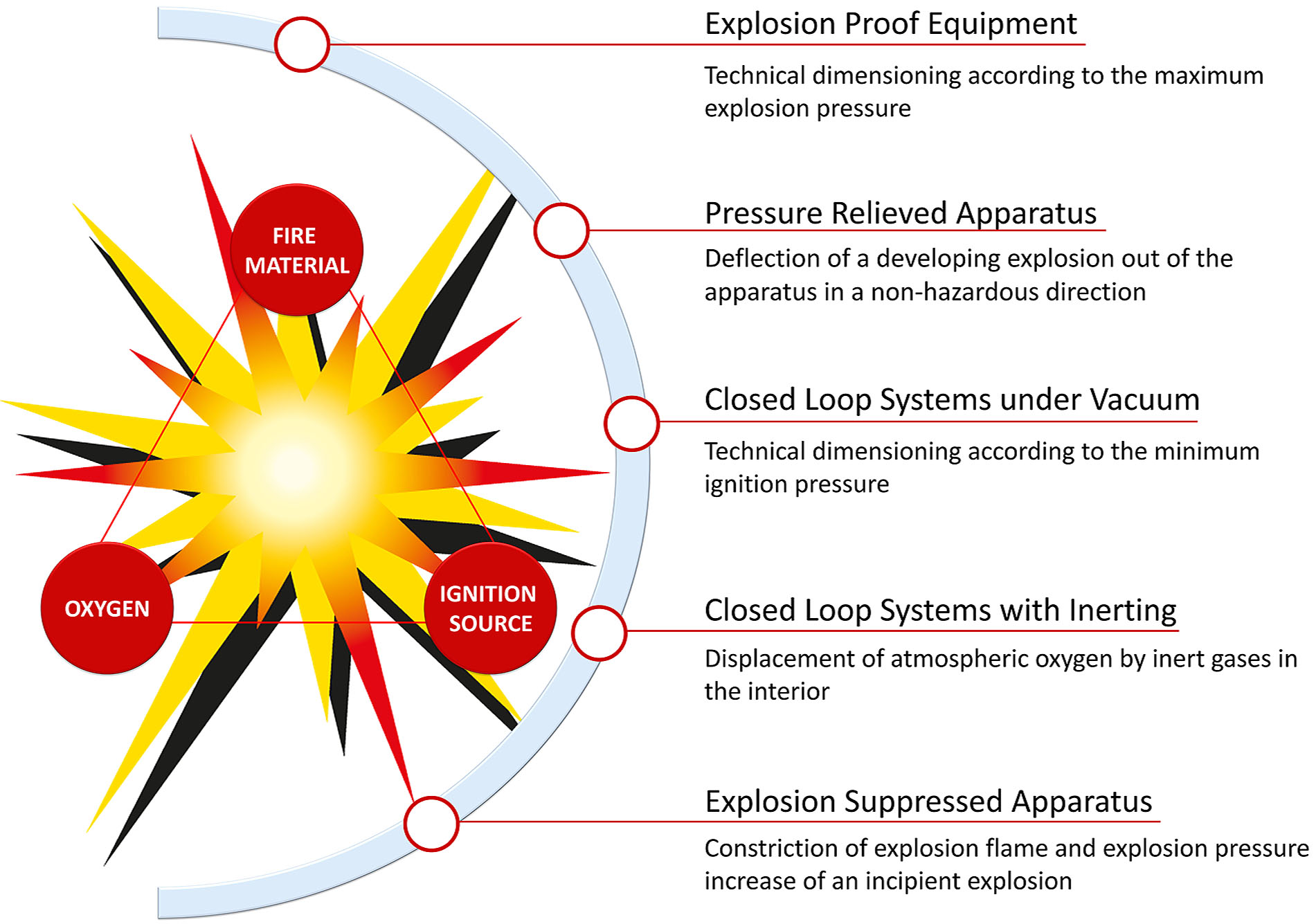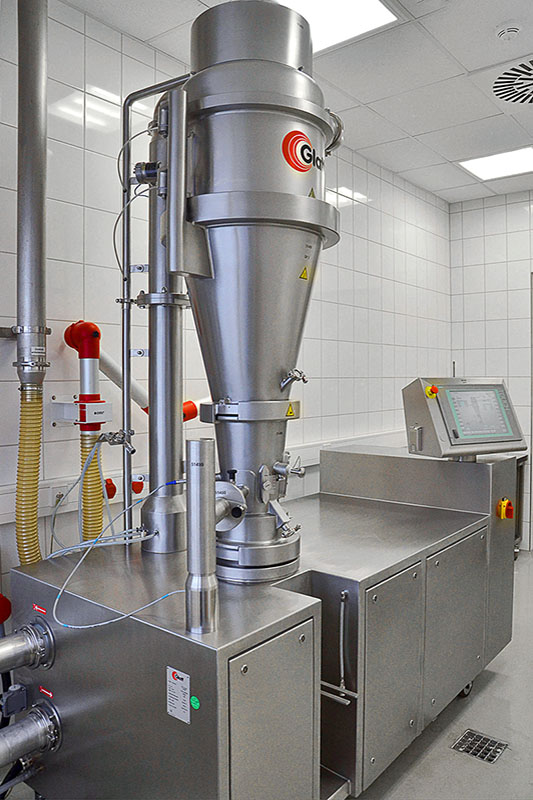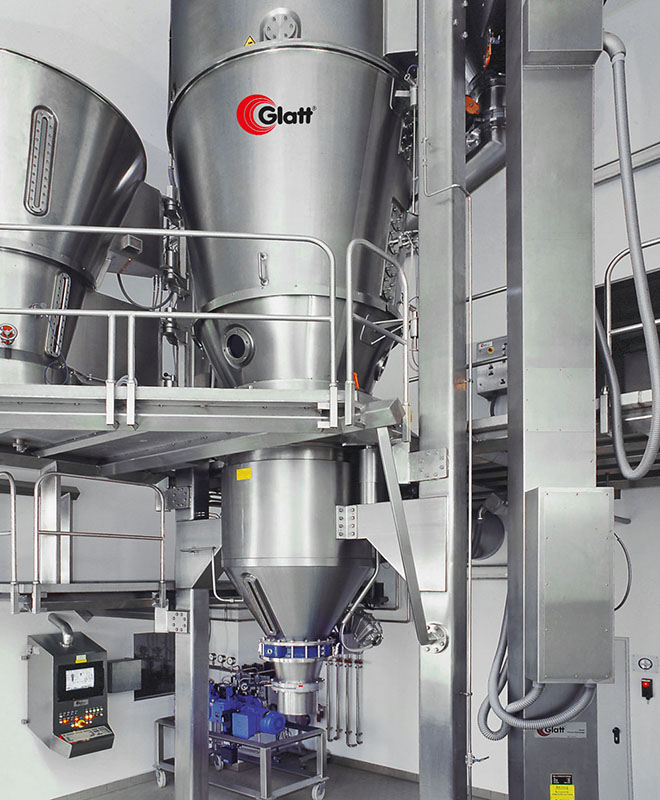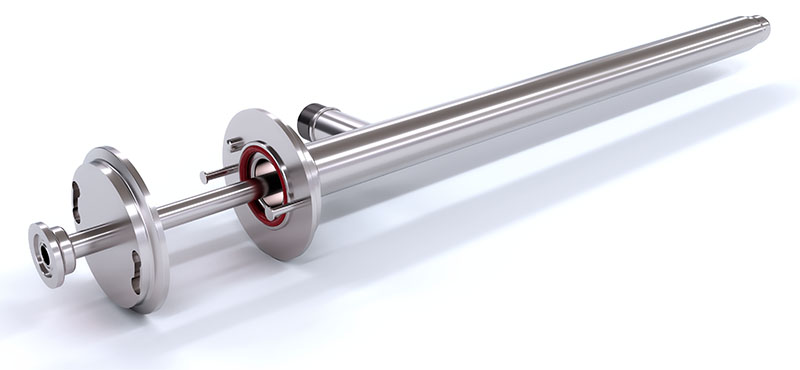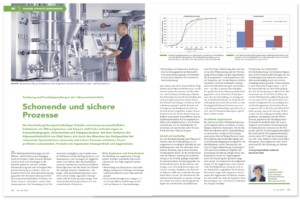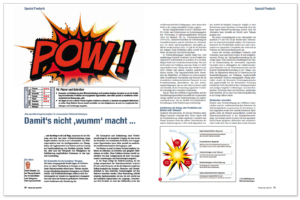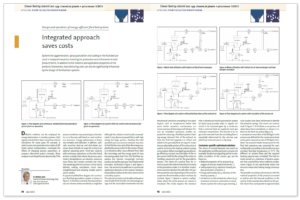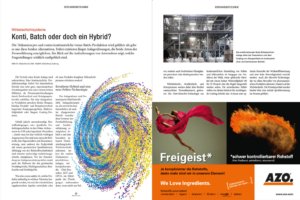Glatt ProCell® PilotSystem, explosion-suppressed pilot plant at the Weimar Technology Center
Design Safety for Fluid Bed Systems and Spouted Bed Systems
Minimize the risks for plant, personal and environmental safety with us.
With our constructive measures for explosion protection for fluidized bed and spouted bed systems, you are on the safe side!
The risk of dust explosions must be absolutely minimized in food and pharmaceutical production and, of course, in all other industries. Design explosion protection is one of the most important precautionary measures for operating fluidized bed and spouted bed systems in a process-safe manner. Atex-compliant designs range from explosion-suppressed to explosion-pressure-resistant apparatus.
When liquids are spray granulated, powders agglomerated or particles encapsulated with a functional coating or layering, the starting materials are often in powder form. Hazardous substances and dusts can also be produced as a result of reaction or decomposition, depending on the material properties present. Organic solvents can pose a further risk.
If it is not possible to avoid ignition sources and ignitable mixtures, Glatt plants can be equipped with devices for explosion protection.
For continuous systems, Glatt offers explosion suppression as standard. In this case, the system pressure in the plant is constantly monitored by dual sensors. Any explosion that occurs results in a rapid rise in pressure. If such a pressure rise is measured, pressure vessels containing extinguishing powder are immediately emptied into the process chamber and the explosion is safely stopped within milliseconds.
For plants in the food industry, these explosion suppression systems are also equipped with hygienic flanges and food-grade extinguishing powder.
Alternatively, Glatt systems can also be protected by inert circulating gas operation, usually as a nitrogen circulating gas system. In this case, inerting not only provides explosion and fire protection, but also protects oxygen-sensitive products during processing.
Directives as guard rails for assessing risks to plant, personal and environmental safety
Risks to plant, personal and environmental safety, including material properties of starting materials, intermediate and end products, auxiliary materials and process engineering conditions are to be assessed in accordance with the Machinery Directive 2006/42/EC. The following are also relevant: for plant manufacturers, EU Directive 94/9/EC for equipment and protective systems in potentially explosive atmospheres (Atex 95), for operators, the minimum requirements of the explosion protection directive 1999/92/EC (Atex 137), ignition source prevention through Atex 99-compliant electrical and non-electrical equipment, the Ordinance on Industrial Safety and Health (BetrSichV), the Ordinance on Hazardous Substances (GefStoffV) and the Explosion Protection Ordinance (11th ProdSV).
Test all process engineering options for risk assessment of the material properties of your products.
A safety concept for a plant can only be derived once the characteristic values for explosion behavior and fire hazard of raw materials and products are known. Corresponding parameters must be discussed for the specific processing conditions present. Also to be considered are the effects of process temperatures and the particle size distribution of solids. As soon as organic solvents come into play in addition to the dust explosion hazard, the risk changes. The thermal stability of substances and the resulting explosion risks are often underestimated, for example, if flammable gaseous substances are formed as a result of thermal decomposition. If the substance values and the potential ignitability of dust-air mixtures are not yet known, special caution is required. In order to determine safety-related characteristic values, representative product samples should be produced and checked in laboratory tests. In the absence of sufficient information to ensure that conventional fluidized bed systems operate as intended, equipment specially designed for safety should be used. The explosion-proof, mobile laboratory unit Glatt ProCell® LabSystem allows testing of all process engineering options and determination of parameters for batch or continuous operation – from dust-explosive powders to hybrid mixtures.
Different zones require different requirements: Rely on Glatt plant design.
Potentially explosive areas – the interior of apparatus and plants as well as the surrounding rooms – are divided into zones. Special operating conditions such as troubleshooting, cleaning, sampling or maintenance must also be taken into account in the assessment.
Explosion protection measures can be divided into:
- primary explosion protection – prevents, restricts or avoids the formation of a dangerous explosive atmosphere
- secondary explosion protection – avoids effective ignition sources and prevents the ignition of hazardous explosive atmospheres
- tertiary (constructive) explosion protection – limits the effects of an explosion to a harmless level
Design precautions are intended to help control and limit the effects of possible explosions in order to exclude any risk to persons. This applies in particular if measures for primary and secondary explosion protection are not sufficient.
For fluidized bed plants and spouted bed plants, the following approaches are primarily pursued:
- design of the apparatus in explosion-pressure or explosion-pressure-shock resistant designs that can withstand the full or reduced explosion pressure
- spatial containment of an explosion – for example, by flame arresters, automatic quick-acting shut-off devices or independently operating shut-off valves
- explosion suppression
Fire protection measures create additional safety to the actual explosion protection.
In addition to explosion protection, fire protection measures create safety. Combustible substances with combustion numbers 3 and higher can lead to fires without explosion if oxygen is present and the process or storage conditions are not safely free of ignition sources.
It is necessary to remove oxygen from the source of the fire.
Fire detection is usually accomplished by additional temperature sensors in the process chamber and on the exhaust line. If the detectors sound the alarm, CO2 from the supply air side pushes through the product bed and displaces the oxygen upwards to the fan, where the CO2 also escapes automatically via appropriate devices.
In case of fires caused by ignition sources without explosion, the following have proven to be effective:
- stationary CO2 extinguishing systems with temperature sensors
- extinguishing cylinder batteries in a separate room
Glatt concepts for explosion protection for fluid bed and spouted bed systems
Glatt ProCell® LabSystem Pro, mobile fluidized bed/spouted bed laboratory plant in pressure-resistant design at the Weimar Technology Center
Glatt AGT® PilotSystem, fluidized bed/spouted bed pilot plant with explosion suppression at the Weimar Technology Center
Glatt fluid bed production plant with vacuum in closed-loop operation at the Weimar Technology Center
Glatt spray nozzle with explosion-proof spray nozzle safety device: The unique assembly and locking concept based on the key-lock principle rules out possible operator error during assembly or cleaning as well as possible hazards in the event of explosions or fire.
Glatt explosion protection for a continuous fluidized bed system type GFG 750
Published article: ‘Gentle and safe processes – Drying and product design in the vacuum fluid bed’ PDF, German
Published article: ‘Better safe than sorry – Design safety for fluid bed systems’ PDF, German
Published article: ‘Atex-compliant system design for high process reliability’ PDF, German
Published article: ‘Integrated approach saves costs – Design and operation of energy-efficient fluid bed systems’ PDF, English
Published article: ‘Fluid bed systems: continuous, batch or a hybrid?’ PDF, German

